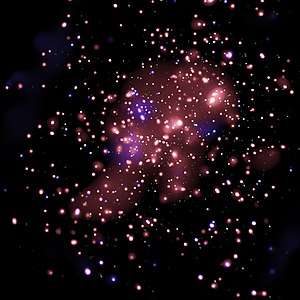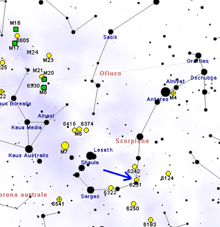NGC 6231
| NGC 6231 | |
|---|---|
 | |
| Observation data (J2000.0 epoch) | |
| Constellation | Scorpius |
| Right ascension | 16h 54m |
| Declination | −41° 48′ |
| Distance | 5.9 kly |
| Apparent magnitude (V) | 2.6 |
| Apparent dimensions (V) | 15.0′ |
| Physical characteristics | |
| Estimated age | 2–7 million years |
| Other designations |
NGC 6171, Ha. I.7, De Cheseaux 9, Lacaille II.13 Dunlop 499, Melotte 153, Collinder 315, Caldwell 76 |

NGC 6231 is an open cluster located near Zeta Scorpii. Zeta1 (HR 6262) is a member of this star cluster. (Its brighter apparent partner, Zeta2 (HR 6271), is only 150 ly from Earth and so is not a cluster member.)
This cluster is estimated about 2–7 million years old,[1] and is approaching the Solar System at 22 km/s. The cluster belongs to the young Scorpius OB1 association in the neighboring Sagittarius Arm of the Milky Way. Zeta1 Scorpii (spectral type O8 and magnitude 4.71.[2]) is the brightest star in the association, and one of the most radiant stars known in the galaxy.[3]
NGC 6231 also includes three Wolf-Rayet stars: HD 151932, HD 152270,[4] and HD 152408.[5]
The cluster was discovered by Giovanni Batista Hodierna before 1654. Hodierna listed it as Luminosae[6] in his catalogue of deep sky observations. This catalogue was included in his book De Admirandis Coeli Characteribuse published in 1654 at Palermo. It was independently observed by other astronomers after Hodierna.
- 1678 Edmond Halley
- 1745-46 de Chéseaux
- 1751-52 Lacaille
The cluster forms the head of the "False Comet", a wider collection of stars from Scorpius OB1 running northward from Zeta Scorpii and NGC 6231 roughly halfway toward Mu Scorpii. The tail is formed by two clusters, Collinder 316 and Trumpler 24. Trumpler 24 is surrounded by the emission nebula IC 4628, also known as the Prawn Nebula, where the tail appears to fan out.
See also
Notes
- ↑ Kuhn, M. A.; Medina, N.; Getman, K. V.; et al. (2017). "The Structure of the Young Star Cluster NGC 6231. I. Stellar Population". The Astronomical Journal. 154 (3). arXiv:1706.00017. Bibcode:2017AJ....154...87K. doi:10.3847/1538-3881/aa76e8.
- ↑ Sky Catalogue 2000.0
- ↑ Crossen & Tirion, Binocular Astronomy, p. 119.
- ↑ Shylaja, B. S (1988). "Study of the Wolf-Rayet members of the cluster NGC 6231". Journal of Astrophysics and Astronomy. 9: 161. Bibcode:1988JApA....9..161S. doi:10.1007/BF02715061.
- ↑ The distinction between OIafpe and WNLha stars. A spectral analysis of HD 151804, HD 152408 and HDE 313846.
- ↑ Stars visible to the naked eye. It meanings "luminous" in Latin.
External links
- SEDS
- NGC 6231 at DOCdb (Deep Sky Observer's Companion)
- NGC 6231 on WikiSky: DSS2, SDSS, GALEX, IRAS, Hydrogen α, X-Ray, Astrophoto, Sky Map, Articles and images